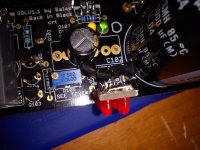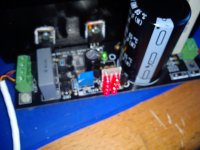Vref cap depends application as stated in the BiB manual: Clocks, MC pre Lytic rest: lineamps. buffer, MM pre Film.
Dynamic impedance:
LM336Z 5V 0,6 Ohms
LM329DZ 6.9V 0,6 Ohms
LM440DIZ 10V 0,8 Ohms
You need much more capacitance to filter very low impedance.😉 Its all a matter of best compromises in a certain circuit and application.
So less is not always more, I'll try to get the R103 in my <10V shunt down to 100 ~300 Ohm by adding more leds to the Vref string. So the impedance goes down, but not to much.
Would the R still be necessary or is the total impedance of 5 led's high enough ?
Would the R still be necessary or is the total impedance of 5 led's high enough ?
So as I understand the best Vref is a combination of static resistance & dynamic resistance.
I think for high Vout target is better to use diodes to low the static resistance of resistor also using minimum two LEDs or more.
I think for high Vout target is better to use diodes to low the static resistance of resistor also using minimum two LEDs or more.
And how do these affect the drift stabilization time? I guess less resistance results in less drift and less stabilization time?
And how do these affect the drift stabilization time? I guess less resistance results in less drift and less stabilization time?
Yes, the worst case is a trimmer.
Has the most ppm and a contact has to have a lifetime limit but I haven't seen anything too serious for drift in a BIB even when keeping the trimmer after initial setup.
Merlin how did it work out? Sounds nice? I gave a look to the references you used, and while it sounds intersting, I cannot really justify the trouble.
How come you did not use just a low noise zener like a 1N4125 for example? From the datasheets, the noise seems more or less the same per component (35-40uV/sqrt(hz)), but with the zener you have only one, and not 13 components contributing to noise.
Plus with the bigish 2K6 VR the low impedance benefit goes out the window (you need some nice R anyway as Nick said to help with filtering)
I read many posts back. Am I missing something?
How come you did not use just a low noise zener like a 1N4125 for example? From the datasheets, the noise seems more or less the same per component (35-40uV/sqrt(hz)), but with the zener you have only one, and not 13 components contributing to noise.
Plus with the bigish 2K6 VR the low impedance benefit goes out the window (you need some nice R anyway as Nick said to help with filtering)
I read many posts back. Am I missing something?
I'm looking the more low dynamic resistance, I left the static resistance for better filtering as per Salas advice. Wich is the dynamic impedance of 1N4125?
It a bit highish. 250ohm max, but the trimmer/resistor needed will be significantly smaller
(edited from 600 which was wrong)
(edited from 600 which was wrong)
Last edited:
Voltage across 2K6 trimmer 8,13V / 2600 ohms = 3mA
Dynamic resistance trimmer 2K6 ohms = 2.6mV / 3mA = 0.866 ohms
Dynamic resistance trimmer 2K6 ohms = 2.6mV / 3mA = 0.866 ohms
Last edited:
Merlin
Is that Vishay MKT1822 at output - what value - happy how It sound
It's a Vishay S102K 1 ohm, don't change the value is the zobel resistor. Subjectively speaking better.
Voltage across 2K6 trimmer 8,13V / 2600 ohms = 3mA
Dynamic resistance trimmer 2K6 ohms = 2.6mV / 3mA = 0.866 ohms
I lost you there. Don t trimmers have a resistive impendance (equal to their resistance)?
AndrewT said:A resistor must have a dynamic impedance equal to it's resistance
Voltage across 2K6 trimmer 8,13V / 2600 ohms = 3mA
Dynamic resistance trimmer 2K6 ohms = 2.6mV / 3mA = 0.866 ohms
???
😕
Dynamic resistance of 2K6 trimmer = 2.6 KOhm
Resistors don't have dynamic resistance, thier resistance is not dependant from current thorugh them, therefore their dynamic resistance equals static resistance.
Merlin, please read THIS
- Home
- Amplifiers
- Power Supplies
- SSLV1.1 builds & fairy tales

